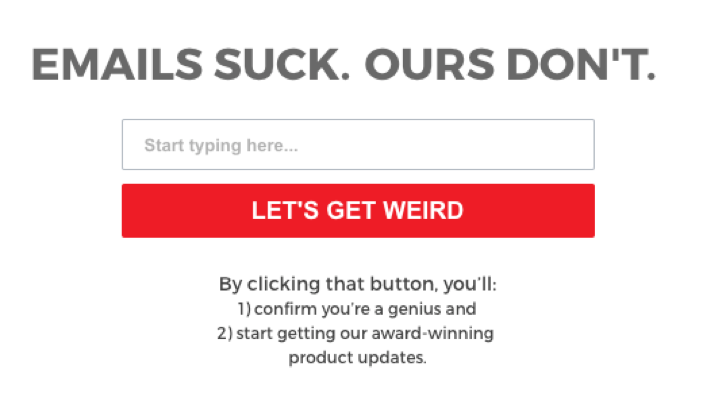4 Signs Your Brand Voice Isn’t Working
Here's what to do about it.
Many business leaders ruminate over their brand’s visual identity – logos, color palette, typeface and graphics. But there’s another important element that often gets overlooked: Brand voice.
Brand voice embodies the personality you reflect across every single communication. It works in tandem with your visuals to connect with your customers and, ultimately, helps you win – or lose – sales and loyalty.
An important consideration
Before we dive into the importance of voice and how to evaluate your own, please keep the next statement in mind. Establishing a consistent and authentic brand voice often requires the advanced skill set of a professional writer. If you have concerns about the creativity and consistency of your voice, we recommend you hire a specialized communications firm to execute on it.
Brand voice essentials
Brand voice isn’t the easiest concept to grasp. It’s an intangible attribute – one that requires commitment and practice.
For example, Morgan Freeman probably wasn’t acknowledged for his powerful, articulate storytelling at the onset of his career. But over time, after he applied a consistent, well-mastered voice and tone to every role from God to the President of the United States, he became universally recognized as one of the greatest voices of all time.
The most successful brands – think Google, Budweiser, Harley Davidson, Old Spice, etc. – assert clear, confident brand voices. And, they express them harmoniously everywhere they go.
5 Signs it’s NOT working for you
On the flip side, many brands have yet to master their own brand voice. They know it’s important, but there are many nuances that demand specialized focus and skill.
If you fall into this category, here are some of the telltale signs you’re ready for a voice makeover.
1. It lacks definition.
Done right, your voice is part of your brand strategy. It rises out of a thoughtfully defined position, messaging platform and personality.
One of my favorite brands, Shinesty, reveals a mission of “bringing people the most outlandish collection of clothing the world has ever seen.” Every communication – from website headlines and blogs to their Instagram posts and e-newsletter subscription box – literally shine because their personality – and brand voice – is weird and fun, just like their goofy products.

(Image: Shinesty website banner)

(Image: Shinesty email subscription pop up)
Now, a manufacturer or financial services firm probably can’t get away with the same cheeky voice. That’s why it’s so important to define your brand position, mission and personality first. (Hint: We can help with that.)
2. It doesn’t reflect what makes YOU, you.
The last thing you want to do is sound like your competitors. While it’s wise to evaluate their voice and tone, develop a distinct voice that sounds like you.
A simple way to help you do this is to identify 3-5 personality traits that make your organization different. Are you quirky and irreverent? Passionate and expressive? Bold and forceful? Define these characteristics further to help you evaluate how you should and shouldn’t speak to your audience.
And remember, your voice should be a reflection of the personalities and culture within the business, not the CEO or owner whose voice should be reserved for supplementary content like articles and other thought leadership materials.
3. It’s not consistent.
Every message contributes to brand voice – your product descriptions, promotional materials, social media, telemarketing and customer service. If your voice varies from platform to platform, customer trust hits a wall. They won’t know what to expect from you.
To evaluate consistency, collect various samples of your content and post them to a whiteboard. Do you notice similarities across a few pieces? Or do the materials sound and feel different?
For example, say you have a new product that’s about to launch. Are you communicating it in a simple, informal way like this:
You ready for something new? We’ve got you covered.
Or in a friendly, empathetic fashion like this:
We’ve carefully listened to your feedback, and we couldn’t be more excited to show you our latest and greatest innovation.
Or, maybe you’re mixing both styles together -- a sign that you have some more work to do.
4. It’s not clear to your writers.
If you’ve defined your voice, you need to ensure that anyone who writes your communications, including freelance writers, get it. Don’t expect the team to nail your voice on the first pass – it takes time and mentorship. That’s where guidelines come in handy.
Ideally, your guidelines outline your various personality traits - think back to No. 2 in this list - and offer some helpful tips (i.e. Do this_______. Not this______.). We went through this exercise with one of our retail clients and didn’t cut any corners. Check out the crystal-clear definitions and directives we developed to help the client convey their unique personality:
Character Trait #1: Friendly & Fun
Even when addressing more serious topics, we stay positive, addressing each topic with sincerity and optimism. In this way, we can maintain a friendly disposition while adapting our approach to suit a wide range of contexts – from celebratory to empathetic.
Directives:
- Avoid yelling in copy – no ALL CAPS – but punctuation is awesome(!)
- Use exclamation points and question marks (and even both, on occasion) to enhance the conversational tone with changes of intonation.
- Drop in details to support your concept or claim and draw audiences in [i.e. “Our support staff is available 24/7 vs. Our support staff is burning the midnight oil to assist you day or night”]
Character Trait #2: Fresh & Unexpected
You can interpret the word “fresh” in a million different ways but, for us, fresh is that moment when we delight our reader with a little spark of truth, a timely turn of phrase, or unexpected play on words. Don’t hesitate to use tried and true statements, but punctuate copy with quick wit.
Directives:
- Illuminate: Present a new perspective on an old assumption.
- Write in the now: Draw from pop culture to write an expression that matters at this very moment.
- Stay a step or two ahead: Hint at tomorrow’s trends and topics, but still write in the present tense.
Find your brand voice - and use it
If you haven’t defined your voice yet, don’t panic. Your brand is a journey; not a destination that you need to perfectly land on today. The first step is to examine your brand – who it truly is – and create a compelling voice to match. Be consistent. Be confident. Be yourself.
When you do, people will listen.
About the Author
Alex is the Content Manager at Muse. In this role, she develops editorial strategies brand stories and press pitches that fuel Muse clients’ marketing activities. Prior to Muse, she worked as a content marketer and strategist for nonprofits and large corporations, including University Hospitals, Flash Seats® and the Council of Smaller Enterprises (COSE). She earned her Master’s and undergraduate degrees from University of Dayton.
More Good Reads

Q&A: Navigating AI Overviews, Site Traffic Drops & the New Frontier of Search
Lauren Konst interviewed Matt Burkarth, a digital marketing expert from WTM Digital, for actionable tips on surviving and thriving in the AI-driven content landscape.

How a Unifying Brand Narrative Helps Your Organization Achieve Strategic Goals
From mission to movement: How you can leverage your association's story to ignite purpose, engage members and increase retention.

